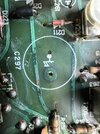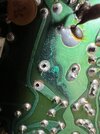A long time ago I found a Tram D201A on the local Facebook marketplace for stupid low money. Initial tests showed that is works.... "kind of"!!!! But I wound up just setting it to the side to hold it for a better time. I keep looking at it.... and started thinking.... "why not now?".
With that, I want to ask for some advice and discussion from the "community".
First off I have a copy of the document that has been floating around for years that recommends various pieces and parts (mostly resistors) on these D201A's. Then... most advice says to just "wholesale swap" electrolytic capacitors. What I do see from time to time... is WARS that start over the concept of "replacing parts across the board" versus "figuring out what is wrong and fixing it" in one like this. I know what my own thoughts are and they lean towards.... replace the old parts FIRST and then see what is LEFT to fix.
With that said, I'd still like to survey the group and see what others think... especially when this is such a "well thought of" radio... and it would be my first tube radio. I am absolutely confident in my ability to handle the work and have even worked with high voltages/tube in amplifiers before.
I mean, I look at this thing... there are multiple boards. I can focus on one at a time replacing caps and the other piece parts so as to "not get lost". It is my thinking that replacing these parts may indeed fix some of the shortcomings! (my memory is a little short on what I found in detail... but for the most part it did work. Piping RF into it... AM RCV worked... as near as I tested.... I got responses on SSB RCV ... it was better in LSB... and a few channels did not want to RCV in USB but I did not record details. It did wiggle my power meter on XMT in AM and LSB... but I do NOT think that it did XMT in USB).
But I think that the time has come and just wanted to know what others thought... and why they think it!!!!!!!
I would appreciate any responses/discussions!
(AND.... I can put up with a good 'jack slapping' too!!!!!!! )
)
Thanks a bunch,
Bob
With that, I want to ask for some advice and discussion from the "community".
First off I have a copy of the document that has been floating around for years that recommends various pieces and parts (mostly resistors) on these D201A's. Then... most advice says to just "wholesale swap" electrolytic capacitors. What I do see from time to time... is WARS that start over the concept of "replacing parts across the board" versus "figuring out what is wrong and fixing it" in one like this. I know what my own thoughts are and they lean towards.... replace the old parts FIRST and then see what is LEFT to fix.
With that said, I'd still like to survey the group and see what others think... especially when this is such a "well thought of" radio... and it would be my first tube radio. I am absolutely confident in my ability to handle the work and have even worked with high voltages/tube in amplifiers before.
I mean, I look at this thing... there are multiple boards. I can focus on one at a time replacing caps and the other piece parts so as to "not get lost". It is my thinking that replacing these parts may indeed fix some of the shortcomings! (my memory is a little short on what I found in detail... but for the most part it did work. Piping RF into it... AM RCV worked... as near as I tested.... I got responses on SSB RCV ... it was better in LSB... and a few channels did not want to RCV in USB but I did not record details. It did wiggle my power meter on XMT in AM and LSB... but I do NOT think that it did XMT in USB).
But I think that the time has come and just wanted to know what others thought... and why they think it!!!!!!!
I would appreciate any responses/discussions!
(AND.... I can put up with a good 'jack slapping' too!!!!!!!
Thanks a bunch,
Bob



